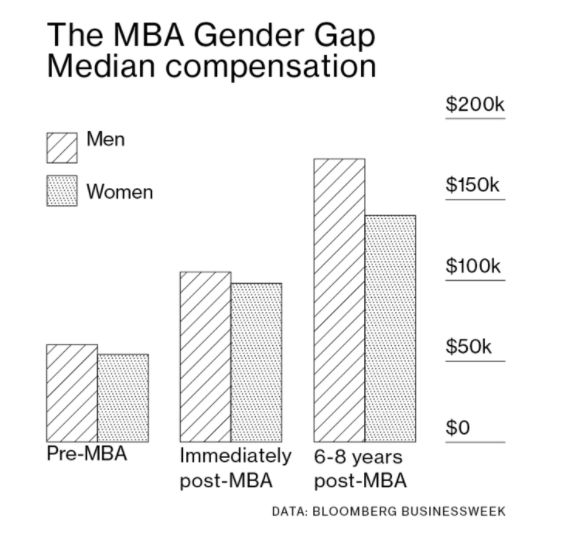
By: Miriam Grobman
The current discussion about the gender pay gap often remains in the title: "Women make 20% of what men make," and each side tries to argue with singular arguments why the other one is wrong: "this happens because of discrimination" or "this happens because women lean out of the workforce or work part time." The reality is, as always, much more complex.
Here are 10 things you should know about the Gender Pay Gap:
1. Women in the United States earn about 80% of what men do. White women earn 75%, Asian women earn 85%, African American women earn 63% and Hispanic women earn 54% of what white men do.

2. Women are more likely to work in lower-paying professions than men. Nevertheless, women now constitute 44% of the workforce in higher-paying management, business and financial occupations and majority of university graduates.

3. Experience and industry and occupation choices account for about 62% of the gender pay gap. The other 38% remains unexplained.

4. When controlling for same profession and role, the pay gap between men and women reduces to single digits, for lower paying jobs.

5a. Yet, even in female-dominated professions, men make more money than women. For example, look at Mary Firme's study of Marketing, a highly female-dominated field:


5b. The higher paid the profession is, the more likely it is to have a double-digit gender pay gap (for example, male investment bankers, lawyers and surgeons earn significantly more than female counterparts).


6. Historically, women might have self-selected into lower paying careers. But even when we look at highly ambitious women, who graduated from top MBA programs, we see a gender pay gap, just 6-8 years out.

Bloomberg studied over 12 thousand alumni of top MBA programs and found that over 6-8 years from graduation, the gap between men and women’s salaries grew from $7k to $35k. Some of the gap was attributed to larger bonuses paid to men.
Women who went into the higher paying careers in Finance, saw even higher average pay gap (earning on average $53k less than men).
7. Women don't reach the higher paying roles at the same rates as men do. According to PayScale, "Men are 85% more likely than women to be VPs or C-Suite Execs by mid-career, and 171% more likely to hold those positions late in their career. Conversely, by the time they reach age 60, more than 60% of women are still working in individual contributor roles, but less than 45% of men are still in this type of job."
8. Looking at 100 thousand job offers and 15 thousand candidates, Hired.com found that companies offered, on average, 3% less to female candidates.

9. Motherhood, on average, brings a pay penalty for women, and mothers have a harder time going back to the workforce after taking time off. Yet about 64% of young mothers remain in the workforce.


"Traditional social roles, the high cost of childcare and a lower level of earnings keep a larger share of women outside the labor force even if they would like a job. In 2015, the number of women who wanted a job but were not currently looking due to childcare or family responsibilities was nearly four times greater than the number of men.[..] While women are increasingly the primary breadwinners in their household, for more than 70 percent of working married couples, men still out-earn women. With women more likely to be the secondary source of income, there may be less pressure to find a job or remain employed”
Source: Wells Fargo Securities
10. The good news is that younger women are asking for more and are getting more. The Hired.com gender wage gap study also shows that female candidates straight out of college have higher salary expectations than men.

This is happening perhaps because of the awareness raised about the topic in the last several years. The good news is that they actually get what they ask for. Women with more experience, however, tend to ask for less than male counterparts.
Lower salary expectations also accumulate over the course of one's career and can lead to higher gender pay gap at more experienced levels.
Where do we go from here?
Closing the gender pay gap is a very complex problem that requires policy solutions like creating incentives for women to pursue certain fields and providing affordable childcare options for parents. In the meantime, what can companies and individuals do to help reduce the gap?
- Analyze and correct pay differences for similar roles within your organization
- Don't look just look at salary figures but also compare overall qualifications and level of experience of women and men in similar roles to identify when women (or men!) aren't being assigned to the right level of seniority
- Increase transparency of compensation and job descriptions per pay grade
- Encourage women to negotiate their salaries and to apply for higher roles. Share benchmarks, when appropriate
- Give special attention to new mothers to help them overcome temporary barriers and keep them in the workforce (and train managers to do the same)
- Don't assume that mothers aren't interested in a promotion. Ask!
--
Miriam Grobman Consulting works with organizations that want to advance more talented women into leadership roles by breaking cultural barriers and giving them the right skills to be successful. Our approach is data-driven, global and collaborative. Contact us if you'd like to discuss the right strategy for your organization. You can follow our Facebook page, Leadership and Women for inspiring stories about women leaders and practical career advice and sign up for our newsletter.
Ellevate Network is a global women’s network: the essential resource for professional women who create, inspire and lead. Together, we #InvestInWomen.
